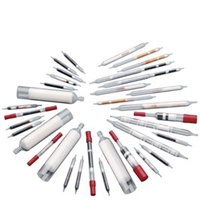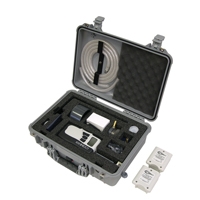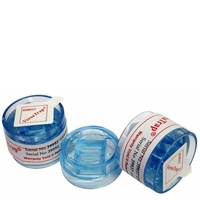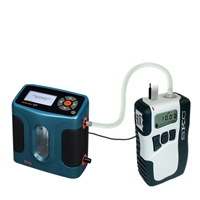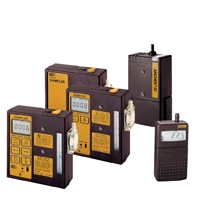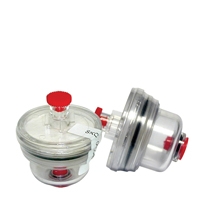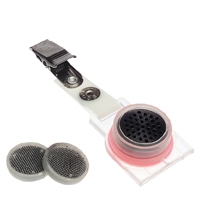Air Sampling
Air Sampling
Contaminants from gases to vapours, along with particulates like dust and fibres have the potential to pose significant harm, and in certain cases, even fatality, to individuals who breathe them in. As a result, the level of exposure to these hazardous substances must be monitored with air sampling equipment to protect workers and prevent respiratory illnesses. Numerous methods exist for sampling air and vapour. These include:
- Personal air sampling - Designed to measure an individual’s exposure to airborne contaminants, personal air sampling pumps are worn by workers by attaching it to their clothing. The air sampling pump is used to draw a sample of air through some type of media (filter, tube etc) that is analysed to determine the concentration of the target contamination. This provides a representative measure of what a person is exposed to during their work shift.
- Area air sampling – Area air sampling pumps are positioned at specific locations to evaluate the concentration of airborne contaminants in a particular area. The pumps help assess overall air quality and identify potential hotspots of contamination.
- Grab sampling –Grab sampling involves collecting discrete air samples at specific time and location using air sampling bags such as Tedlar bags.
The sampling method should be selected based on the nature of the contaminants, the duration of the monitoring and the specific goals to be achieved with the air and vapour sampling.
We are proud to deliver accurate and reliable personal air sampling pumps, area sampling and real-time monitoring equipment available for sale and rent. Our extensive rental fleet of air and vapour sampling equipment that is owned, calibrated and maintained in-house. Additionally, Air-Met Scientific is a trusted supplier of air and vapour sampling media and accessories to health and safety professionals and organisations across Australia.
What is Air Sampling?
Air sampling is the process of identifying and measuring airborne contaminants using air sampling equipment. As a component of occupational health and safety as well as environmental monitoring, air sampling is conducted to monitor hazardous substances and inform the implementation and evaluation of control measures in a safety plan. Air sampling is necessary both to ensure that workers are not exposed to harmful levels of gases, vapours and particulates, and that health and safety regulations are complied with.
Types of Contaminants in Air Sampling
As airborne contaminants in a workplace can present significant health and safety issues for workers, identification, and quantification of these contaminants via air monitoring assessments are an essential component of any health and safety program. Contaminants that can be tested for can be classed into three main categories based on their physical properties
- Particulates – particulate matter is further subdivided into 6 types consisting of aerosols, dust, fumes, smokes, mist and fibres.
- Vapours – gaseous phase of a substance that usually exists as a liquid or solid at normal room temperature and pressure.
- Gases – a substance that usually exists as a liquid or solid at normal room temperature and pressure.
Why is Air Sampling Important in the Workplace?
- Identifying and Assessing Airborne Hazards: Air sampling helps occupational hygiene and health and safety professionals to identify and assess airborne health hazards to employees. This includes the evaluation of substances like dust, chemicals, fumes, fibres and biological agents that could be potentially harmful when inhaled.
- Compliance with Regulations: Compliance with local, state, and national regulations is crucial. Air sampling helps organisations ensure they meet legal requirements related to occupational exposure limits (OELs) and permissible exposure limits (PELs).
- Preventing Occupational Illnesses: By monitoring air quality, organisations can proactively prevent occupational illnesses and reduce the risk of long-term health issues among employees.
Australia's Premier Supplier for Trusted Air Sampling Equipment
Air-Met Scientific is a leading supplier of air sampling, air monitoring and air quality equipment in Australia. We are proud distributors of SKC’s high quality products since 1984. Trusted by occupational hygienists and industry professionals alike, our extensive air sampling product range includes:
-
Personal and Area Air Sample Pumps
Our range of SKC air sampling pumps are available in both high and low flow rate options to accommodate various sampling requirements. These pumps are available for both sale and rental.
-
Pump Calibrators and Accessories
Air-Met Scientific offers a comprehensive range of primary and secondary pump calibrators from industry leading manufacturers such as SKC Inc. These calibrators play a crucial role in ensuring the precise flow rate accuracy of air sampling pumps. We also supply air sampling accessories such as standard rotameters and field rotameters for qualitative flow rate measurements during air sampling and flowmeters to precisely measure and control the flow rate of air during sampling.
-
Particulate Sampling Media
Air-Met Scientific offers a range of particulate sampling media to collect and analyse solid particles and aerosols from the air. Our product range includes filters, samplers, cyclones, DPM cassettes and impactors. These media are an essential component of air quality monitoring, occupational hygiene assessments and various scientific and industrial applications.
-
Gas and Vapour Sampling Media
Our extensive range of gas and vapour sampling media and accessories include adjustable low flow tube holders, bulk sorbents, SKC Tedlar Bags, passive samplers and more.
Air-Met Scientific offers a wide array of products ranging from air sampling pumps to calibrators, and accessories to provide our clients with a one-stop solution for all their air sampling equipment needs. So, if you are looking for an air sampling unit or a low flow air pump, we can assist you from our convenient office locations positioned across Australia. We offer local support and can help you in selecting the right pumps and sampling media for your monitoring requirements.
Contact your local Air-Met Scientific to discuss your individual needs.
Air Sampling Frequently Asked Questions
Here are some commonly asked questions about air sampling equipment. If you can’t find the answers here, get in touch and our team will be happy to help.
Yes, Air-Met Scientific offers air sampling pump rental for short and long-term monitoring. Our range of air sampling pumps include personal air sampling pumps, area air sampling pumps, asbestos air sampling pumps and more. Contact your local Air-Met Scientific Rental office to discuss your monitoring requirements. Air-Met Scientific have rental offices in most major cities including Melbourne, Sydney, Brisbane, Mackay, Perth and Adelaide.
Air sampling pump calibration is an important process that ensures that air sampling pumps are functioning properly and providing accurate measurements. Air-Met Scientific provides calibration services for air sampling pumps including NATA ISO/IEC 17025 accredited calibration and testing of air sampling pumps and flow meters.
An air sampling train is a series of connected sampling devices used to collect and measure air quality parameters such as the concentration of gases, particulate matter, and other airborne pollutants. The train typically includes a pump such as the SKC AirChek TOUCH Sampling Pump to draw in air, a filter or sorbent material to collect the pollutants, and instruments to measure the collected samples.
Air sampling trains can be used in a variety of applications, including environmental monitoring, occupational health and safety assessments, and industrial hygiene evaluations. They may be used to monitor the air quality in a specific location over time, or to collect samples for laboratory analysis to determine the concentration of specific pollutants.
The design of an air sampling train can vary depending on the specific application and the parameters being measured, e.g. some trains may use different types of filters or sorbent materials to collect different pollutants.
Active air sampling and passive air sampling are two techniques used to collect air samples for monitoring and assessing air quality. The primary difference between the two methods is how they collect air samples.
Active air sampling uses a pump to actively draw air into a sampling device, where the airborne particles or gases of interest are captured on a collection medium, such as a filter or sorbent material. Active sampling provides a precise control over the sampling time and volume, which can improve the accuracy and reproducibility of the results. It is commonly used for monitoring ambient air quality in outdoor environments and for occupational health and safety assessments in workplaces.
Passive air sampling, on the other hand, relies on the natural movement of air to transport airborne particles or gases to a collection medium, which is typically a sorbent material or a diffusion sampler. Passive sampling devices are lightweight, easy to deploy, and do not require a power source, making them a convenient option for air quality monitoring in a range of settings. However, passive sampling typically has a lower collection rate and may be less selective for specific pollutants than active sampling.
The choice between active and passive air sampling depends on the specific application and the parameters being measured.
Asbestos air sampling is a process used to measure the concentration of airborne asbestos fibres in a given environment. Asbestos is a mineral that was widely used in building materials due to its durability and fire resistance, but it can cause serious lung diseases when inhaled. The air sampling process involves collecting air samples using a sampling pump capable of sampling up to 5L/min such as the SKC XR5000 over a specific time period, typically 8 hours or longer, using a filter cassette or other sampling media.
The collected samples are then sent to a laboratory for analysis to determine if the concentration of airborne asbestos fibres in the environment exceeds regulatory or safety guidelines. The results of the analysis can be used to assess the risk of exposure to asbestos fibres in buildings and other environments and to inform decisions about the need for remediation or other measures to reduce the risk of exposure to this hazardous material.
The SKC Air Sampling Guide is a comprehensive reference manual that provides guidance on air sampling methods, equipment, and techniques. Published by SKC Inc., a leading manufacturer of air sampling equipment and supplies, the SKC Sampling Guide information is based on OHSA/NIOH/ASTM/EPA and HSE Methods for over 2500 compounds.
The guide is designed to provide practical information to help users including occupational hygienists and environmental consultants to make informed decisions about air sampling for a wide range of applications, including occupational hygiene, environmental monitoring, and industrial hygiene. Click below to learn more about how you can use the SKC Air Sampling Guide.
Air sampling is an important process in various fields such as environmental monitoring and occupational hygiene. It is a process of capturing a contaminant from a known volume of air, measuring it, and expressing it as a concentration. Some key considerations when conducting air sampling are:
- Define the Sampling Objectives - Identify the purpose of conducting air sampling, whether it is to assess indoor air quality, monitor workplace pollutants or investigate potential sources of contamination.
- Sampling Location: The sample collected must be a representation in terms of time and location so the results can be compared with regulatory levels. Some location factors to consider are proximity to pollution sources, airflow patterns, and potential exposure pathways.
- Sampling Time: Based on the objectives of conducting the air sampling it is important to determine the appropriate sampling duration (e.g., minutes, hours, or days) and the specific contaminants of interest.
- Sampling Frequency: Determine the appropriate frequency of air sampling by considering factors such as the duration of exposure, work shifts, and potential changes in processes.
- Appropriate Equipment: Choosing the right air sampling equipment will depend on the nature of the contaminants and the specific requirements of the task. Air sampling can be conducted using battery operated personal air sampling pumps, air sampling bags to collect a discrete air sample for further analysis or sorbent tubes for solvent extraction.
- Sampling Media: Select appropriate sampling media (e.g., filters, sorbent tubes, impingers) that are compatible with the target pollutants and sampling method.
- Sample Handling: It is important to properly handle and store air samples to prevent contamination and ensure accurate results.
- Data Analysis: Analyse air sampling data to assess compliance with OELs/PELs and identify trends or areas that may require corrective actions.
- Determining Compliance – Ensure sampling protocol complies with relevant local, state, and federal regulations or industry standards.
- Employee Training: Train employees on the importance of air sampling, how to use personal protective equipment (PPE), and the significance of adhering to safety protocols.
These considerations are essential for conducting effective air sampling to obtain accurate and reliable data for various applications. Consult with your occupational hygienist for further information on guidelines and requirements when conducting air sampling activities.
There are no regulations on how often air sampling should be performed but every industry has air quality compliance standards from regulatory bodies that they must meet. An air monitoring program with defined control measures should be implemented in the workplace to minimise the risk of respiratory hazards to workers. The control measures should contain information on type of pollutants, the WHS control measures if a new hazard or risk is identified and a schedule or timeline on how often the risks should be reviewed.This will ensure effective air quality monitoring on the worksite and adherence to exposure standards.
Performed to ensure the workplace or environmental air meets regulatory standards, air sampling is relevant to homes, offices, hospitals, and public spaces, to ensure the well-being of workers. Contaminants in the air can range from dust, vapours, fibres and gases to bioaerosols present in waste management and recycling facilities.
Various industries and workplaces utilise air sampling equipment and media such as chemical manufacturing plants, construction sites, firefighting operations and research laboratories. At homes and offices, air sampling media is often used to identify indoor air pollutants such as asbestos, mould and VOCs.

